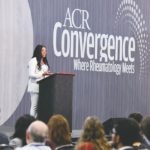
Chugunova Anastasia / shutterstock.com
TOWN HALL—When the COVID pandemic shifted meetings and other team functions in the working world to remote video encounters, team leaders were challenged to find new ways to build and support their teams. When the team could only come together remotely, the need for cohesion, morale building, recognition and common culture took on even greater importance. Some of the challenges and opportunities for building cohesion in teams forced by the pandemic to interact remotely were explored in the ACR’s May 6 virtual Division Director Town Hall.
Remote teamwork is new to rheumatology divisions and programs, noted Roberto Caricchio, MD, chief of the Section of Rheumatology, Temple University, Philadelphia, when introducing the speakers. “I don’t know about you, but I had no training in this matter, and I am still struggling to provide new ways of mentoring and leading.”
David Sluss, PhD, associate professor of organizational behavior, the Georgia Institute of Technology, Atlanta, and Adam Stoverink, PhD, associate professor and director of the MBA program at the Sam M. Walton College of Business, University of Arkansas, Fayetteville, explored the management challenges of team building in both one-on-one supervisory relationships and Zoom-based team meetings.
Rheumatology division directors may find their recommendations helpful both in the virtual world and in new, hybrid models combining in-person and remote work that are likely to emerge as the pandemic eases.
Effective one-on-one relationships with subordinates are essential for leaders, Dr. Sluss said. “During the pandemic, most—if not all—of our relational interactions have been virtual. These virtual work relationships and one-on-one interactions are here to stay,” he said. The challenge for leaders is how to make them feel more personalized.
He asked attendees to consider the ingredients of effective relationships with their superiors and to expect the same could apply to relationships with those they supervise. Participants identified good listening, availability, mutual respect, good and open communication, forthrightness, transparency, empathy, personal access to the leader as needed and—especially—trust as some of the key ingredients.
Research shows that relationships with subordinates are built on rewards, both tangible and intangible, and on support for their search for meaning and purpose in their work, Dr. Sluss said. Ultimately, these two approaches are the foundation of evidence-based strategies for building trust—which is inextricably tied to perceptions of fair treatment. Building trust takes time and effort.
For the leader, being too busy can be the enemy of perceived fairness, while demonstrating that one is less busy—and more available—enhances subordinates’ experience of feeling treated fairly. The challenge is that most leaders say they’ve become more busy, rather than less, during the pandemic. Conversations get rushed, technical tasks take precedence, and the perception of fairness by subordinates goes down.
Making the Encounter Personal

Dr. Caricchio
The face-to-face encounter has a built-in ethos, with an element of non-verbal and off-the-cuff communication, Dr. Sluss said. “When the encounter is virtual, it’s much more planned, maybe more stilted. Okay, how do we make it feel more personal in the virtual environment?” Expect meetings with fellows to take more time and more energy to read each other when meeting via the camera. Ask open-ended questions, and give them time to reply.
Do they trust us? Do we trust them, and how do we show that? Dr. Sluss posed. Rather than checking up on fellows, thereby suggesting a lack of trust, he recommended checking in with them: “‘Tell me how it’s going. What do you need from me?’ More autonomy for workers should mean more communication with them, not less.” And all of that takes patience, which Sarah Schnitker, Baylor University, Waco, Texas, defines as “the propensity to act calmly in the face of frustration or adversity.”1
Dr. Sluss encouraged division directors to cultivate patience, learn to act calm and go slow when that’s needed, rather than always trying to go faster. The goal is not just operational speed—moving quickly—but strategic speed, reducing the time it takes to deliver value, he said. Leaders should swap their stopwatch for a compass, and prioritize when it’s most important to slow down.
How to handle virtual meetings poses dilemmas because many people say they’re having too many. Yet meetings are essential for building culture. “You can’t overcommunicate in a crisis, and many leaders handled that well. But then they never stopped, continuing to overcommunicate as the pandemic faded,” Dr. Stoverink said.
What’s happening now, the speakers emphasized, is the emergence of hybrid work models in which some employees spend some or all of their work life at home as others return to the office—and to the rheumatology clinic. This represents another massive disruption in work life. Seventy-three percent of employees say they want current flexible work options to stay permanent.
Adaptations to these hybrid work models will need to be nuanced, especially for the team’s culture. Remote is here to stay, while at the same time employees are craving the social connections of the office, Dr. Stoverink said. “But not everyone is ready for business as usual.”
The transition to the pandemic and then to the hybrid model is also an opportunity to stop and revisit, strengthen and even change established office culture, he added. Leaders should decide what kind of culture they want to preserve and what to leave behind. But he also recommended integrating the team into this redesign process.
Reimagining the Culture

Dr. Stoverink
How can we reimagine our work culture when the rituals and ceremonies of the office are not as accessible anymore—not to mention how to integrate new employees into the culture and the rhythms of the office? How will team culture look in the new hybrid normal? How will we reimagine the office to reinforce the culture in new and better ways, ensuring those at home and those in the office are experiencing the same culture?
Bumping into colleagues in the hallways or by the water cooler is important. “We didn’t realize how much those conversations mattered for building strong workplace relationships,” Dr. Stoverink said. Meanwhile, burnout is a massive organizational issue in many settings. He recommended gauging the team’s stress levels, asking questions, analyzing their responses and watching out for the more troublesome manifestations of job stress and burnout.
What else can leaders do to build strong relationships on the team? Create time for personal bonding and make space for relationships to thrive. Encourage and reward those team members who provide social support to one another. “Make meetings more intentional, inclusive and social. Make sure everyone is heard,” he said. That may mean assigning a moderator or facilitator who isn’t the team leader.
“Strive for well-planned social interactions where everyone feels included,” Dr. Stoverink said. Other tips include making a habit of offering empathetic recognition, which can be easily done by routinely finding small ways to express gratitude. Share weekly goals with the team. “I encourage you as leaders to be intentional,” he added. “The future of work does not look the same. Virtual and hybrid work cultures were going to be part of our future, anyway. COVID-19 just accelerated it.”
Larry Beresford is a medical journalist in Oakland, Calif.
Reference
- Schnitker SA. An examination of patience and well-being. J Posit Psychol. 2012 Jul;7(4):263–280.


